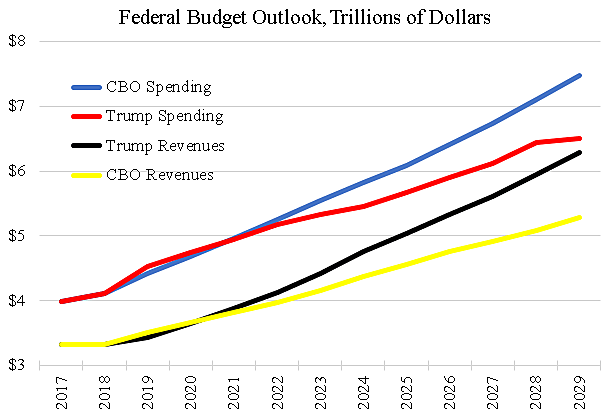The Trump administration has released its federal budget for 2020. The document lays out taxing and spending proposals and provides projections through 2029.
The chart compares Trump’s proposed revenues and spending to the most recent CBO projections. These are from CBO’s “alternative fiscal scenario” (AFS), which assumes that the Trump tax cuts do not expire after 2025 and that discretionary budget caps are lifted.
The Trump budget also assumes that the tax cuts do not expire. However, his budget is much more optimistic about economic growth than the CBO, and so estimated revenues are higher.
Note that the tax cuts went into effect in 2018 but federal revenues did not fall. Revenues would have been higher without the cuts, but rising deficits are being driven by relentless spending increases, not a shortage of revenues.
Even with the tax cuts in place, revenues are expected to rise from $3.5 trillion this year to $5.3 trillion in 2029 under the CBO projections. If we restrained annual spending growth to a reasonable 1.8 percent, the budget would be balanced in 10 years.
The president’s budget proposes balancing in 15 years, partly achieved by spending cuts. The budget proposes reforms to student loans, welfare programs, disability payments, and federal employee retirement benefits. The nondefense discretionary part of the budget would be cut from $685 billion in 2019 to $511 billion by 2029. Those would be good reforms, as discussed here.
However, the budget would increase defense and security spending. It would “bolster our global force posture,” which sounds like more spending on misguided foreign activities. We should fund our military to defend America, not the globe.
The budget would spend more on moon exploration, which would be wasteful because we’ve already been there. These days, we should let private enterprise pay for space, as with the recent Israeli probe that landed on the moon and took a selfie. Also misguided, the Trump budget proposes new spending on paid leave and infrastructure.
Campaigning in 2016, Trump promised to eliminate the federal debt or at least reduce it. But the debt has already increased $2 trillion on his watch, and even with the reforms in his new budget, the government would add another $8 trillion in debt by 2029.
Large cuts are needed, but will Congress even consider Trump’s modest reforms? The Washington Post reported “Unlike in the past two years, White House officials say they plan to forcefully fight for the proposed cuts.”
I hope they do because the nation has never been in such a troubling fiscal situation. Federal debt is soaring even after a decade of economic growth. Debt is imposing a rising cost that burdens all of us. Politicians have always had incentives to spend, but never before has Washington been so irresponsible.

